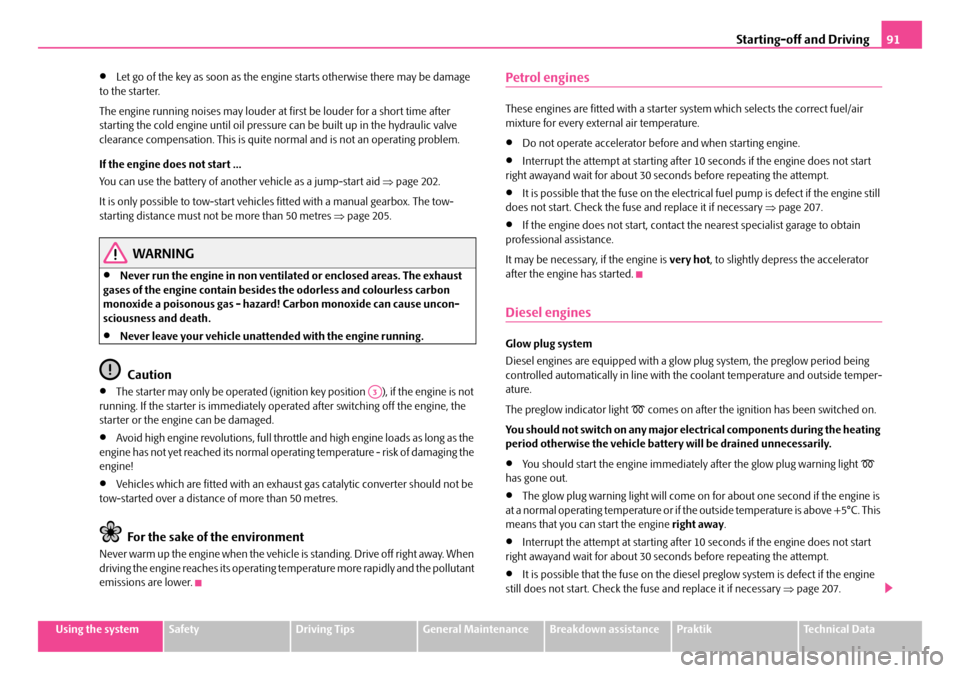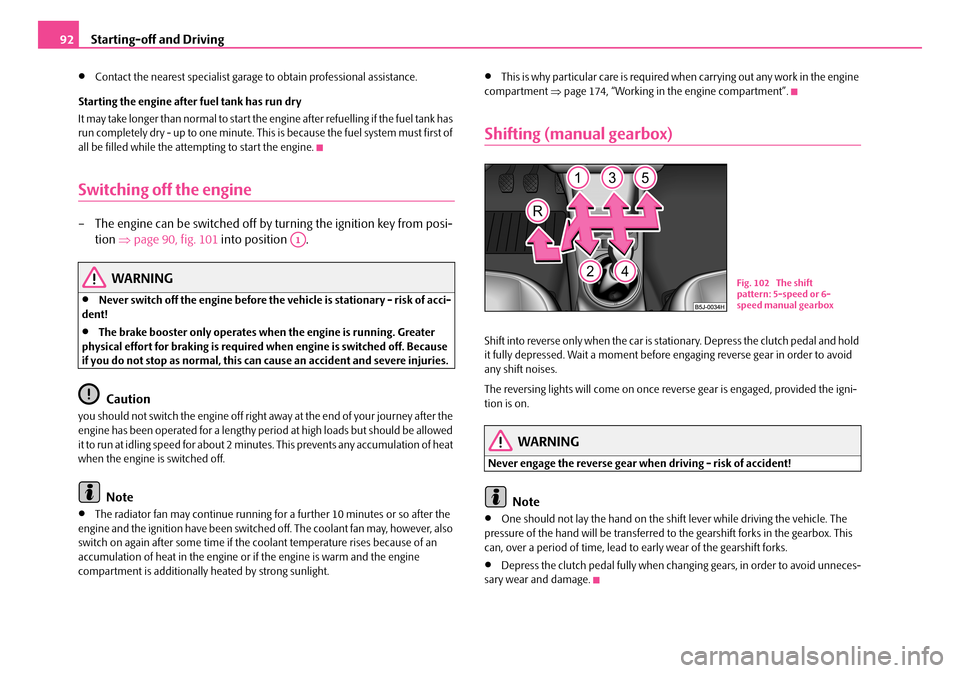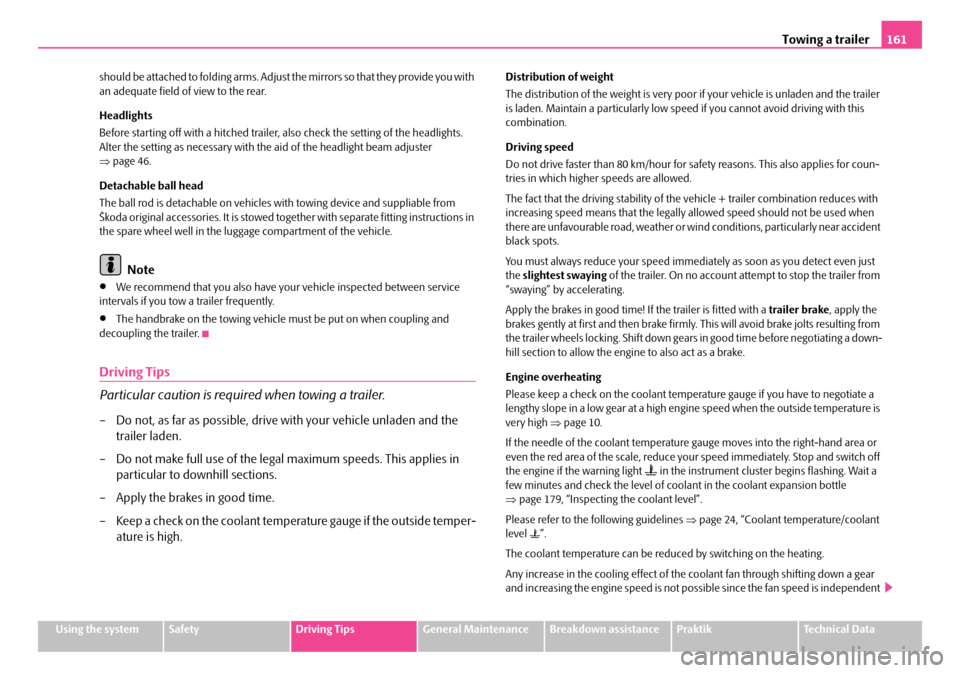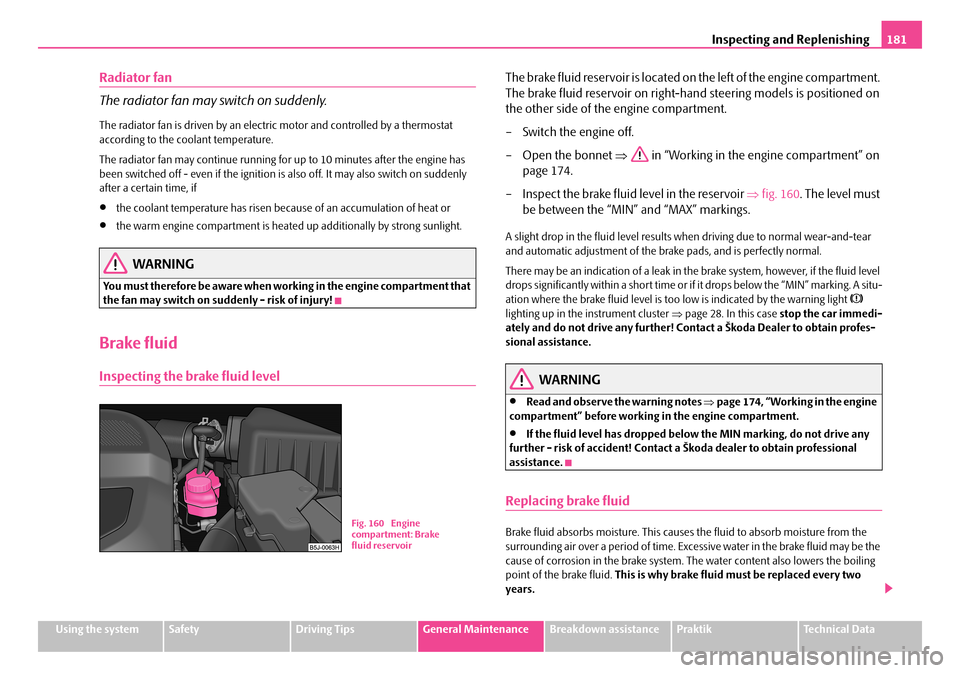coolant temperature SKODA ROOMSTER 2007 1.G User Guide
[x] Cancel search | Manufacturer: SKODA, Model Year: 2007, Model line: ROOMSTER, Model: SKODA ROOMSTER 2007 1.GPages: 248, PDF Size: 46.44 MB
Page 92 of 248

Starting-off and Driving91
Using the systemSafetyDriving TipsGeneral MaintenanceBreakdown assistancePraktikTechnical Data
•Let go of the key as soon as the engine starts otherwise there may be damage to the starter.
The engine running noises may louder at first be louder for a short time after starting the cold engine until oil pressure can be built up in the hydraulic valve clearance compensation. This is quite normal and is not an operating problem.
If the engine does not start ...
You can use the battery of anothe r vehicle as a jump-start aid ⇒page 202.
It is only possible to tow-start vehicl es fitted with a manual gearbox. The tow- starting distance must not be more than 50 metres ⇒page 205.
WARNING
•Never run the engine in non ventilated or enclosed areas. The exhaust gases of the engine contain besides the odorless and colourless carbon monoxide a poisonous gas - hazard! Carbon monoxide can cause uncon- sciousness and death.
•Never leave your vehicle unattended with the engine running.
Caution
•The starter may only be operated (ignition key position ), if the engine is not running. If the starter is immediately oper ated after switching off the engine, the starter or the engine can be damaged.
•Avoid high engine revolutions, full throttle and high engine loads as long as the engine has not yet reached its normal oper ating temperature - risk of damaging the engine!
•Vehicles which are fitted wi th an exhaust gas catalytic converter should not be tow-started over a distance of more than 50 metres.
For the sake of the environment
Never warm up the engine when the vehicle is standing. Drive off right away. When driving the engine reaches its operating temperature more rapidly and the pollutant emissions are lower.
Petrol engines
These engines are fitted with a starter system which selects the correct fuel/air mixture for every external air temperature.
•Do not operate accelerator before and when starting engine.
•Interrupt the attempt at starting after 10 seconds if the engine does not start right awayand wait for about 30 seconds before repeating the attempt.
•It is possible that the fuse on the electric al fuel pump is defect if the engine still does not start. Check the fuse and replace it if necessary ⇒page 207.
•If the engine does not start, contact the nearest specialist garage to obtain professional assistance.
It may be necessary, if the engine is very hot, to slightly depress the accelerator after the engine has started.
Diesel engines
Glow plug system
Diesel engines are equipped with a glow plug system, the preglow period being controlled automatically in line with the coolant temperature and outside temper- ature.
The preglow indicator light comes on after the ignition has been switched on.
You should not switch on any major electrical components during the heating period otherwise the vehicle battery will be drained unnecessarily.
•You should start the engine immediately after the glow plug warning light has gone out.
•The glow plug warning light will come on for about one second if the engine is at a normal operating temperature or if the outside temperature is above +5°C. This means that you can start the engine right away.
•Interrupt the attempt at starting after 10 seconds if the engine does not start right awayand wait for about 30 seconds before repeating the attempt.
•It is possible that the fuse on the diesel preglow system is defect if the engine still does not start. Check the fuse and replace it if necessary ⇒page 207.
A3
NKO A05R 20 MR08.book Page 91 Wednesday, March 28, 2007 9:42 AM
Page 93 of 248

Starting-off and Driving92
•Contact the nearest specialist garage to obtain professional assistance.
Starting the engine after fuel tank has run dry
It may take longer than normal to start the engine after refuelling if the fuel tank has run completely dry - up to one minute. This is because the fuel system must first of all be filled while the attempting to start the engine.
Switching off the engine
– The engine can be swit ched off by turning the ignition key from posi-
tion ⇒page 90, fig. 101 into position .
WARNING
•Never switch off the engine before the vehicle is stationary - risk of acci- dent!
•The brake booster only operates when the engine is running. Greater physical effort for braking is required when engine is switched off. Because if you do not stop as normal, this can cause an accident and severe injuries.
Caution
you should not switch the engine off right away at the end of your journey after the engine has been operated fo r a lengthy period at high loads but should be allowed it to run at idling speed for about 2 minutes . This prevents any accumulation of heat when the engine is switched off.
Note
•The radiator fan may continue running fo r a further 10 minutes or so after the engine and the ignition have been switched off. The coolant fan may, however, also switch on again after some time if the coolant temperature rises because of an accumulation of heat in the engine or if the engine is warm and the engine compartment is additionally heated by strong sunlight.
•This is why particular care is required when carrying out any work in the engine compartment ⇒page 174, “Working in the engine compartment”.
Shifting (manual gearbox)
Shift into reverse only when the car is stationary. Depress the clutch pedal and hold it fully depressed. Wait a moment before engaging reverse gear in order to avoid any shift noises.
The reversing lights will come on once reverse gear is engaged, provided the igni- tion is on.
WARNING
Never engage the reverse gear when driving - risk of accident!
Note
•One should not lay the hand on the shift lever while driving the vehicle. The pressure of the hand will be transferred to the gearshift forks in the gearbox. This can, over a period of time, lead to early wear of the gearshift forks.
•Depress the clutch pedal fully when changing gears, in order to avoid unneces- sary wear and damage.
A1
Fig. 102 The shift pattern: 5-speed or 6-speed manual gearbox
NKO A05R 20 MR08.book Page 92 Wednesday, March 28, 2007 9:42 AM
Page 162 of 248

Towing a trailer161
Using the systemSafetyDriving TipsGeneral MaintenanceBreakdown assistancePraktikTechnical Data
should be attached to folding arms. Adjust the mirrors so that they provide you with an adequate field of view to the rear.
Headlights
Before starting off with a hitched trailer, also check the setting of the headlights. Alter the setting as necessary with th e aid of the headlight beam adjuster ⇒ page 46.
Detachable ball head
The ball rod is detachable on vehicles with towing device and suppliable from Škoda original accessories. It is stowed together with separate fitting instructions in the spare wheel well in the luggage compartment of the vehicle.
Note
•We recommend that you also have yo ur vehicle inspected between service intervals if you tow a trailer frequently.
•The handbrake on the towing vehicle must be put on when coupling and decoupling the trailer.
Driving Tips
Particular caution is required when towing a trailer.
– Do not, as far as possible, drive with your vehicle unladen and the
trailer laden.
– Do not make full use of the legal maximum speeds. This applies in
particular to downhill sections.
– Apply the brakes in good time.
– Keep a check on the coolant temper ature gauge if the outside temper-
ature is high.
Distribution of weight
The distribution of the weight is very poor if your vehicle is unladen and the trailer is laden. Maintain a particularly low speed if you cannot avoid driving with this combination.
Driving speed
Do not drive faster than 80 km/hour for safety reasons. This also applies for coun- tries in which higher speeds are allowed.
The fact that the driving stability of the vehicle + trailer combination reduces with increasing speed means that the legally allowed speed should not be used when there are unfavourable road, weather or wind conditions, particularly near accident black spots.
You must always reduce your speed immedi ately as soon as you detect even just the slightest swaying of the trailer. On no account attempt to stop the trailer from “swaying” by accelerating.
Apply the brakes in good time! If the trailer is fitted with a trailer brake, apply the brakes gently at first and then brake firmly . This will avoid brake jolts resulting from the trailer wheels locking. Shift down gears in good time before negotiating a down- hill section to allow the engine to also act as a brake.
Engine overheating
Please keep a check on the coolant temperature gauge if you have to negotiate a lengthy slope in a low gear at a high engine speed when the outside temperature is very high ⇒page 10.
If the needle of the coolant temperature gauge moves into the right-hand area or even the red area of the scale, reduce yo ur speed immediately. Stop and switch off the engine if the warning light in the instrument cluste r begins flashing. Wait a few minutes and check the level of coolant in the coolant expansion bottle ⇒ page 179, “Inspecting the coolant level”.
Please refer to the following guidelines ⇒page 24, “Coolant temperature/coolant level ”.
The coolant temperature can be reduced by switching on the heating.
Any increase in the cooling effect of the coolant fan through shifting down a gear and increasing the engine speed is not possible since the fan speed is independent
NKO A05R 20 MR08.book Page 161 Wednesday, March 28, 2007 9:42 AM
Page 182 of 248

Inspecting and Replenishing181
Using the systemSafetyDriving TipsGeneral MaintenanceBreakdown assistancePraktikTechnical Data
Radiator fan
The radiator fan may switch on suddenly.
The radiator fan is driven by an electric motor and controlled by a thermostat according to the coolant temperature.
The radiator fan may continue running fo r up to 10 minutes after the engine has been switched off - even if the ignition is also off. It may also switch on suddenly after a certain time, if
•the coolant temperature ha s risen because of an accumulation of heat or
•the warm engine compartment is heated up additionally by strong sunlight.
WARNING
You must therefore be aware when working in the engine compartment that the fan may switch on suddenly - risk of injury!
Brake fluid
Inspecting the brake fluid level
The brake fluid reservoir is located on the left of the engine compartment.
The brake fluid reservoir on right-hand steering models is positioned on
the other side of the engine compartment.
– Switch the engine off.
– Open the bonnet ⇒ in “Working in the engine compartment” on
page 174.
– Inspect the brake fluid level in the reservoir ⇒fig. 160. The level must
be between the “MIN” and “MAX” markings.
A slight drop in the fluid level results when driving due to normal wear-and-tear and automatic adjustment of the br ake pads, and is perfectly normal.
There may be an indication of a leak in the brake system, however, if the fluid level drops significantly within a short time or if it drops below the “MIN” marking. A situ-ation where the brake fluid level is too low is indicated by the warning light lighting up in the instrument cluster ⇒page 28. In this case stop the car immedi- ately and do not drive any further! Cont act a Škoda Dealer to obtain profes- sional assistance.
WARNING
•Read and observe the warning notes ⇒page 174, “Working in the engine compartment” before working in the engine compartment.
•If the fluid level has dropped below the MIN marking, do not drive any further - risk of accident! Contact a Škoda dealer to obtain professional assistance.
Replacing brake fluid
Brake fluid absorbs moisture. This causes the fluid to absorb moisture from the surrounding air over a period of time. Excessive water in the brake fluid may be the cause of corrosion in the brake system. Th e water content also lowers the boiling point of the brake fluid. This is why brake fluid must be replaced every two years.
Fig. 160 Engine compartment: Brake fluid reservoir
NKO A05R 20 MR08.book Page 181 Wednesday, March 28, 2007 9:42 AM
Page 241 of 248

Index240
Child safety seat
on the front passenger seat . . . . . . . . . . . . . . . 138
Safety information . . . . . . . . . . . . . . . . . . . . . . . 137
Child seat . . . . . . . . . . . . . . . . . . . . . . . . . . . . . . . . . . . 140
Classification into groups . . . . . . . . . . . . . . . . . 140
ISOFIX system . . . . . . . . . . . . . . . . . . . . . . . . . . . . 143
Children and safety . . . . . . . . . . . . . . . . . . . . . . . . . . 137
Chrome parts . . . . . . . . . . . . . . . . . . . . . . . . . . . . . . . 165
Cigarette lighter . . . . . . . . . . . . . . . . . . . . . . . . . . . . . . 71
Cleaning . . . . . . . . . . . . . . . . . . . . . . . . . . . . . . . . . . . . 163
Climatronic
Air outlet vents . . . . . . . . . . . . . . . . . . . . . . . . . . . . 88
Defrosting windows . . . . . . . . . . . . . . . . . . . . . . . 87
Recirculated air mode . . . . . . . . . . . . . . . . . . . . . 87
Setting temperature . . . . . . . . . . . . . . . . . . . . . . . 87
Clock . . . . . . . . . . . . . . . . . . . . . . . . . . . . . . . . . . . . . . . . 13
Clothes hooks . . . . . . . . . . . . . . . . . . . . . . . . . . . . . . . . 77
Cockpit
General view . . . . . . . . . . . . . . . . . . . . . . . . . . . . . . . 8
Compartments . . . . . . . . . . . . . . . . . . . . . . . . . . . . . . . 72
Computer . . . . . . . . . . . . . . . . . . . . . . . . . . . . . . . . . . . . 13
Convenience operation . . . . . . . . . . . . . . . . . . . . . . . 42
Converting/masking over headlights . . . . . . . . . . 158
Coolant . . . . . . . . . . . . . . . . . . . . . . . . . . . . . . . . . . . . . 178
replenishing . . . . . . . . . . . . . . . . . . . . . . . . . . . . . 180
Warning light . . . . . . . . . . . . . . . . . . . . . . . . . . . . . 24
Coolant level
Warning light . . . . . . . . . . . . . . . . . . . . . . . . . . . . . 24
Coolant temperature gauge . . . . . . . . . . . . . . . . . . . 10
Coolant temperature/coolant level
Warning light . . . . . . . . . . . . . . . . . . . . . . . . . . . . . 24
Cornering lights . . . . . . . . . . . . . . . . . . . . . . . . . . . . . . . 45
Warning light . . . . . . . . . . . . . . . . . . . . . . . . . . . . . . 22
Correct seated position . . . . . . . . . . . . . . . . . . . . . . 119
Counter for distance driven . . . . . . . . . . . . . . . . . . . . 11
Cruise control system . . . . . . . . . . . . . . . . . . . . . . . . . . 94
Cup holder
front . . . . . . . . . . . . . . . . . . . . . . . . . . . . . . . . . . . . . . 69
rear . . . . . . . . . . . . . . . . . . . . . . . . . . . . . . . . . . . . . . . 69
D
Deactivating an airbag . . . . . . . . . . . . . . . . . . . . . . . 135
Defrosting rear window . . . . . . . . . . . . . . . . . . . . . . . . 49
Defrosting windows . . . . . . . . . . . . . . . . . . . . . . . 79, 82
De-icing the windows . . . . . . . . . . . . . . . . . . . . . . . 166
Diesel . . . . . . . . . . . . . . . . . . . . . . . . . . . . . . . . . . . . . . 170
Diesel engines
Starting the engine . . . . . . . . . . . . . . . . . . . . . . . . . 91
Diesel particle filter . . . . . . . . . . . . . . . . . . . . . . . . . . 152
Warning light . . . . . . . . . . . . . . . . . . . . . . . . . . . . . . 29
Digital clock . . . . . . . . . . . . . . . . . . . . . . . . . . . . . . . . . . 13
Direction indicators . . . . . . . . . . . . . . . . . . . . . . . . . . . 47
Warning light . . . . . . . . . . . . . . . . . . . . . . . . . . . . . . 22
Display . . . . . . . . . . . . . . . . . . . . . . . . . . . . . . . . . . . . . . . 16
Distance driven . . . . . . . . . . . . . . . . . . . . . . . . . . . . . . . 11
Door
Child safety lock . . . . . . . . . . . . . . . . . . . . . . . . . . . 32
Warning light . . . . . . . . . . . . . . . . . . . . . . . . . . . . . . 25
Door, luggage compartment door and bonnet ajar warning . . . . . . . . . . . . . . . . . . . . . . . . . . . . . . . . . 18
Driving economically . . . . . . . . . . . . . . . . . . . . . . . . 154
Driving time . . . . . . . . . . . . . . . . . . . . . . . . . . . . . . . . . . 16
E
EDL . . . . . . . . . . . . . . . . . . . . . . . . . . . . . . . . . . . . . . . . . 147
Electric power-operated window
Operational faults . . . . . . . . . . . . . . . . . . . . . . . . . 42
Electrically adjustable rear mirror . . . . . . . . . . . . . . 53
Electronic Differential Lock . . . . . . . . . . . . . . . . . . . 147
Warning light . . . . . . . . . . . . . . . . . . . . . . . . . . . . . 27
Electronic Differential Lock (EDL) . . . . . . . . . . . . . 147
Electronic immobiliser . . . . . . . . . . . . . . . . . . . . . 24, 31
Warning light . . . . . . . . . . . . . . . . . . . . . . . . . . . . . 24
Electronic stability programme (ESP) . . . . . . . . . . 145
Warning light . . . . . . . . . . . . . . . . . . . . . . . . . . . . . 27
Emergency locking of the door . . . . . . . . . . . . . . . . . 36
Engine
starting . . . . . . . . . . . . . . . . . . . . . . . . . . . . . . . . . . . 90
switching off . . . . . . . . . . . . . . . . . . . . . . . . . . . . . . 92
Engine compartment
Safety information . . . . . . . . . . . . . . . . . . . . . . . . 174
Engine electronics
Warning light . . . . . . . . . . . . . . . . . . . . . . . . . . . . . 23
Engine oil . . . . . . . . . . . . . . . . . . . . . . . . . . . . . . . . . . . 176
change . . . . . . . . . . . . . . . . . . . . . . . . . . . . . . . . . . 178
check . . . . . . . . . . . . . . . . . . . . . . . . . . . . . . . . . . . . 177
replenishing . . . . . . . . . . . . . . . . . . . . . . . . . . . . . 178
Warning light . . . . . . . . . . . . . . . . . . . . . . . . . . . . . 25
Engine revolutions counter . . . . . . . . . . . . . . . . . . . . . 9
Environment . . . . . . . . . . . . . . . . . . . . . . . . . . . . . . . . 154
Environmental compatibility . . . . . . . . . . . . . 154, 157
ESP . . . . . . . . . . . . . . . . . . . . . . . . . . . . . . . . . . . . . . . . . 145
Warning light . . . . . . . . . . . . . . . . . . . . . . . . . . . . . 27
NKO A05R 20 MR08.book Page 240 Wednesday, March 28, 2007 9:42 AM